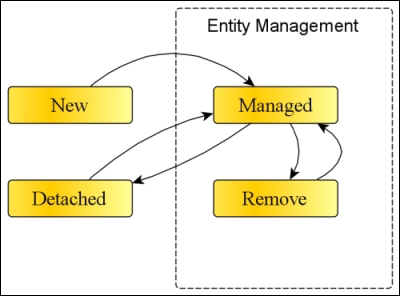- Java EE 7 Developer Handbook
- Table of Contents
- Java EE 7 Developer Handbook
- Credits
- About the Author
- Acknowledgment
- About the Reviewers
- www.PacktPub.com
- Preface
- 1. Java EE 7 HTML5 Productivity
- 2. Context and Dependency Injection
- Software engineering definitions
- The Context and Dependency Injection service
- Standalone CDI application
- Building the standalone project with Gradle
- Using the DeltaSpike CDI container tests
- Injecting arbitrary objects using Producers
- Advanced CDI
- The Arquillian test framework
- CDI and crosscutting concerns
- Summary
- 3. Enterprise Java Beans
- 4. Essential Java Persistence API 3.2
- Entities
- Running a simple entity bean test
- The lifecycle of an entity bean
- EntityManager
- Moving further along with entity beans
- JPQL
- The entity bean relationships
- Configuration of persistence and the entity beans
- Summary
- 5. Object-Relational Mapping with JPA
- Adding finesse to entity beans
- Entity relationships revisited
- Mapping entity inheritance hierarchy
- Extended entities
- Troubleshooting entity persistence
- Summary
- 6. Java Servlets and Asynchronous Request-Response
- 7. Java API for HTML5WebSocket
- 8. RESTful Services JAX-RS 2.0
- 9. Java Message Service 2.0
- 10. Bean Validation
- 11. Advanced Topics in Persistence
- A. Java EE 7 Platform
- B. Java EE 7 Persistence
- C. Java EE 7 Transactions
- D. Java EE 7 Assorted Topics
- Index
Entities are managed by the instances of javax.entity.EntityManager in the Java application. Entities have a lifecycle of four states: new, managed, detached, and removed.
An entity bean is in the new state when it is instantiated with the Java new operator, or serialized from the object stream. In the new state, entity bean is not associated with any EntityManager instance whatsoever. An alternative way to specify this is to say that the entity bean has no persistence context, and therefore, no persistence identity.
An entity bean is in the managed state when it is associated with an EntityManager instance and that instance is still valid in terms of the JVM. A managed entity bean has a definite persistence context and identity.
An entity bean is in the detached state when it is no longer associated with an EntityManager. A detached entity can be found if the entity bean is serialized into an object stream so that it is transferred across the network from one JVM to another. A detached entity can be found if its associated EntityManager goes out of scope.

Fig: Diagram of entity Lifecycle states
A detached entity bean can be reattached with EntityManager during a merge operation, as we will see later in the discussion around management.
-
No Comment
